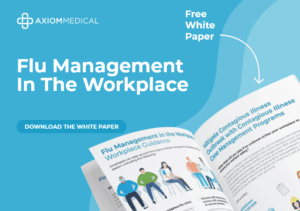“Be prepared” isn’t just a Scout motto—it’s also the key for handling bites and stings. The trick? Having a fact-based plan that’s free of popular myths and ideas leftover from the time of folk medicine.
To set the record straight, we’re tackling some of the most pervasive mistruths about bites, stings, and workplace safety. Here’s what you really need to know to protect yourself and your team from the fallout of venomous wildlife encounters.

Myth 1: Venomous Bites and Stings Always Cause Immediate Symptoms
While many venomous bites or stings can cause localized tissue swelling and systematic effects immediately, others may have effects that are subtle at first, but deadlier later.
For example, bites from the brown recluse spider are often painless initially. But after 2 to 8 hours, they could develop into something more serious. What starts as a mild redness may progress to tissue damage or necrosis, requiring medical attention. Similarly, the coral snake, a highly venomous species found in the United States, also delivers a nearly painless bite. But its neurotoxic venom can cause deadly respiratory paralysis several hours later if left untreated. Painful bites can have delayed symptoms too. Hours after a rattlesnake bite, victims risk coagulopathy (e.g., excessive bleeding) and systemic toxicity (e.g., organ failure).
The takeaway? Don’t take chances – ensure that bite victims get their wound looked at immediately, even if it looks benign, to prevent dangerous side effects from catching them by surprise later on.
Myth 2: You Should Suck Out Snake Venom
Before modern medicine, the idea of physically removing venom from a wound seemed logical, as it was thought to prevent the poison from spreading through the body. This belief was reinforced by survival stories, cultural traditions, and even early medical guides that recommended suction as a treatment.
The idea persists even now. In the popular 2010 remake “True Grit,” the Jeff Bridges character Rooster sucks the venom out of the arm of the young protagonist Mattie Ross (played by Hailee Steinfeld) to save her from necrosis. Despite Rooster’s best efforts, the little girl’s arm is amputated – which is no surprise, because sucking venom out has zero first-aid benefit. It’s a misuse of valuable response time and risks additional infection by introducing bacteria from the others person’ s mouth. Instead, workplace first aiders should keep the bite victim calm, immobilize the affected area, avoid further irritating actions like icing or cutting the wound, and get to a healthcare facility immediately, as only antivenom can properly treat the venom.
Myth 3: Workplace Wildlife Risks Are Limited to Rural Areas
A common misconception is that snake and spider bites are a concern only for people working or spending time in wild, rural areas. While it’s true that forests, fields, and other natural environments often house venomous species, bites from these creatures can occur almost anywhere — including urban and suburban settings.
Snakes, for example, can make their way into residential areas, construction sites, warehouses, and beneath outdoor equipment. Spiders, especially species like the brown recluse or black widow, are often found in dark, undisturbed areas such as garages, storage spaces, or behind furniture. In both cases, workplaces that might seem safe from wildlife exposure can unknowingly harbor these venomous creatures.
The danger lies in underestimating the possibility. So yes, it could happen to you or another team member at your workplace. Don’t dismiss the risk of encountering a spider under a supply shelf or a snake beneath some pallets. Employers should consider assessing potential wildlife risks in their specific work environment and develop a clear response protocol.
Myth 4: All First Aid Kits Are Equipped for Snake and Spider Bites
It’s easy to assume that a workplace first aid kit contains everything needed to handle emergencies, including venomous snake and spider bites. Unfortunately, this is not the case.
Antivenom is the only proven treatment for venomous bites, and standard kits don’t include it because it requires specialized storage and administration by trained medical professionals. So, once again, the first step should be coordinating emergency care for the victim.
However, there are several critical items that can help manage the situation while the victim awaits care. Elastic bandages or compression wraps, for instance, could slow venom spread for most snake bites, but they’re not present in all basic kits. For spider bites, having antiseptic wipes and appropriate dressings is essential for cleaning and covering wounds to prevent infection. Additional easy add-ons to upgrade kits are splints for immobilization and employee manuals for bite management.
Myth 5: Venom Always Acts the Same on Everyone
A common misunderstanding is that venom from snake or spider bites affects every person in the same way. But the reality is far more complex. Venom’s impact can vary greatly depending on multiple factors. These include the type and amount of venom injected, the location of the bite, and the victim’s individual characteristics, such as age, weight, health, and immune response.
Take black widow spider bites, for example. This spider’s neurotoxic venom can cause a range of effects. Some individuals may only experience local pain and mild irritation, while others may suffer severe muscle cramping, abdominal pain, or even difficulty breathing. A child or an elderly individual is more likely to face more serious complications compared to a healthy adult. Similarly, rattlesnake venom can have varying effects depending on the species involved and the size of the victim. A bite from an Eastern diamondback rattlesnake might lead to rapid tissue destruction and severe systemic symptoms in one person, while another might only suffer localized swelling and pain.
Preexisting health conditions further complicate how venom is processed by the body. Someone with respiratory issues or cardiovascular disease could face life-threatening symptoms from a bite or sting that might be less severe for someone without such conditions. The bite’s size and location also matter. A big bite closer to major blood vessels may lead to faster venom distribution and more dramatic symptoms than a smaller bite on a less vascularized area such as a finger or toe.
Since it’s impossible to predict exactly how venom will affect an individual, no bite or sting should ever be dismissed. Train employees to take all bites or stings seriously, regardless of perceived severity. Hesitation in seeking treatment could result in preventable complications.
Fact: Expert Preparation Requires Expert Advice
Want to hear directly from an expert on venomous bites? Watch a replay of our webinar, Venomous Threats: Safeguarding Against Springtime Bites with Chief Medical Officer, Dr. Scott Cherry, and Emily Roberts, owner of Snake Discovery, where we’ll equip you with essential tools for identifying dangerous species, responding to bites, and enhancing outdoor safety. Don’t miss this opportunity to keep your team safe this season!

Cain Boney is a contributor to Axiom Medical’s blog. With a career dedicated to writing about the workplace, Cain focuses on how employee well-being affects organizational success and sustainability in the long term.










